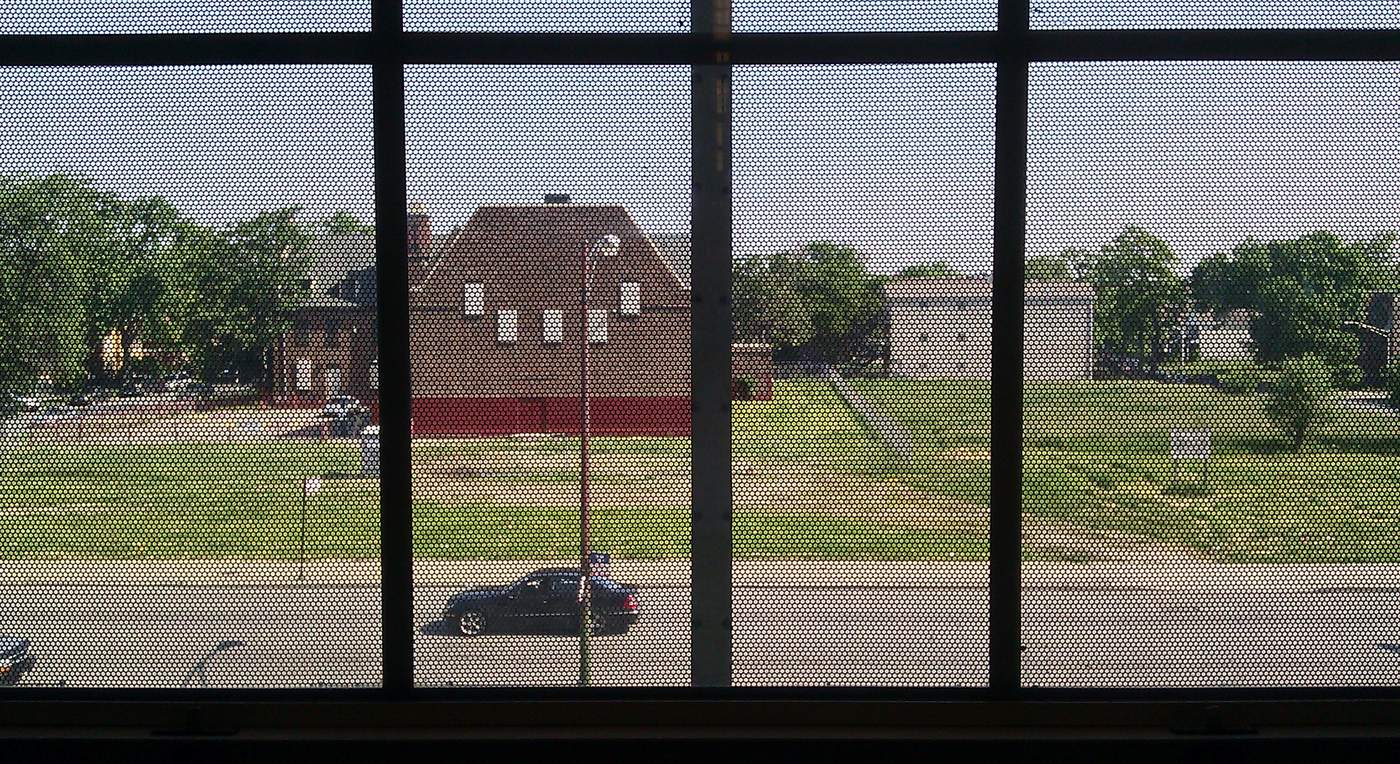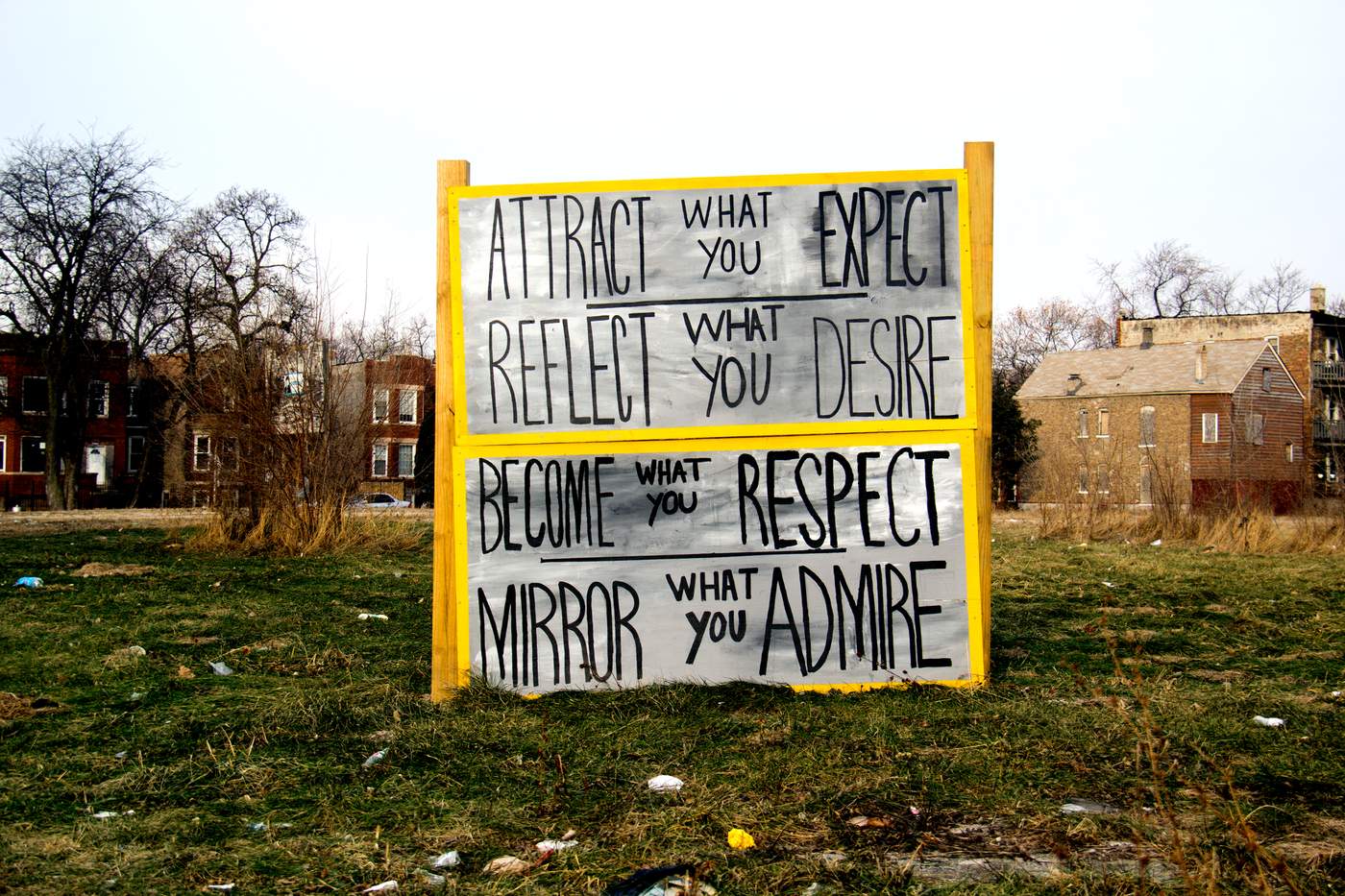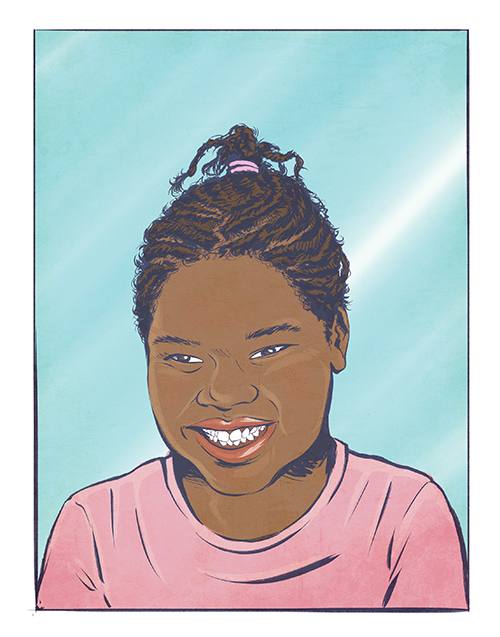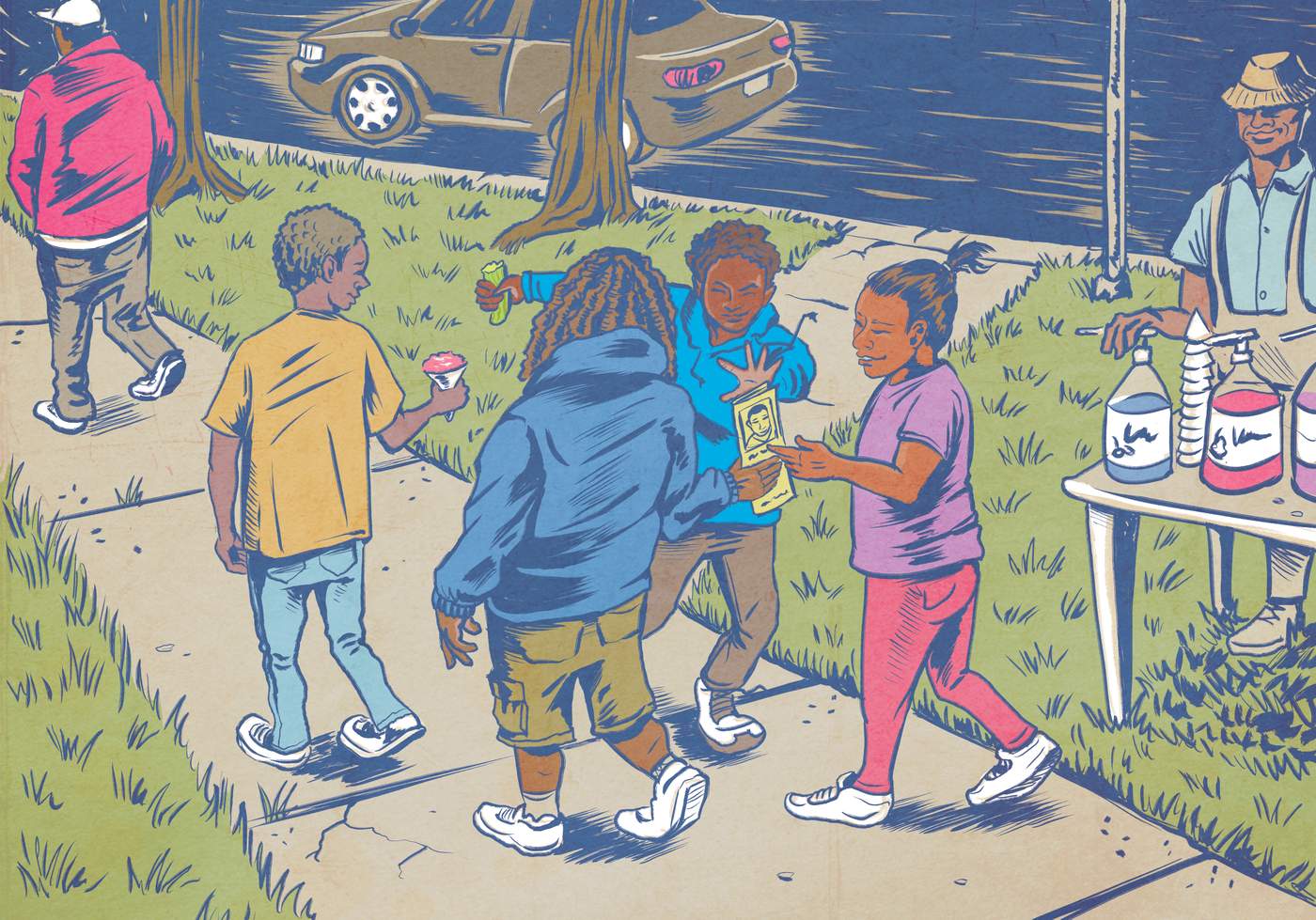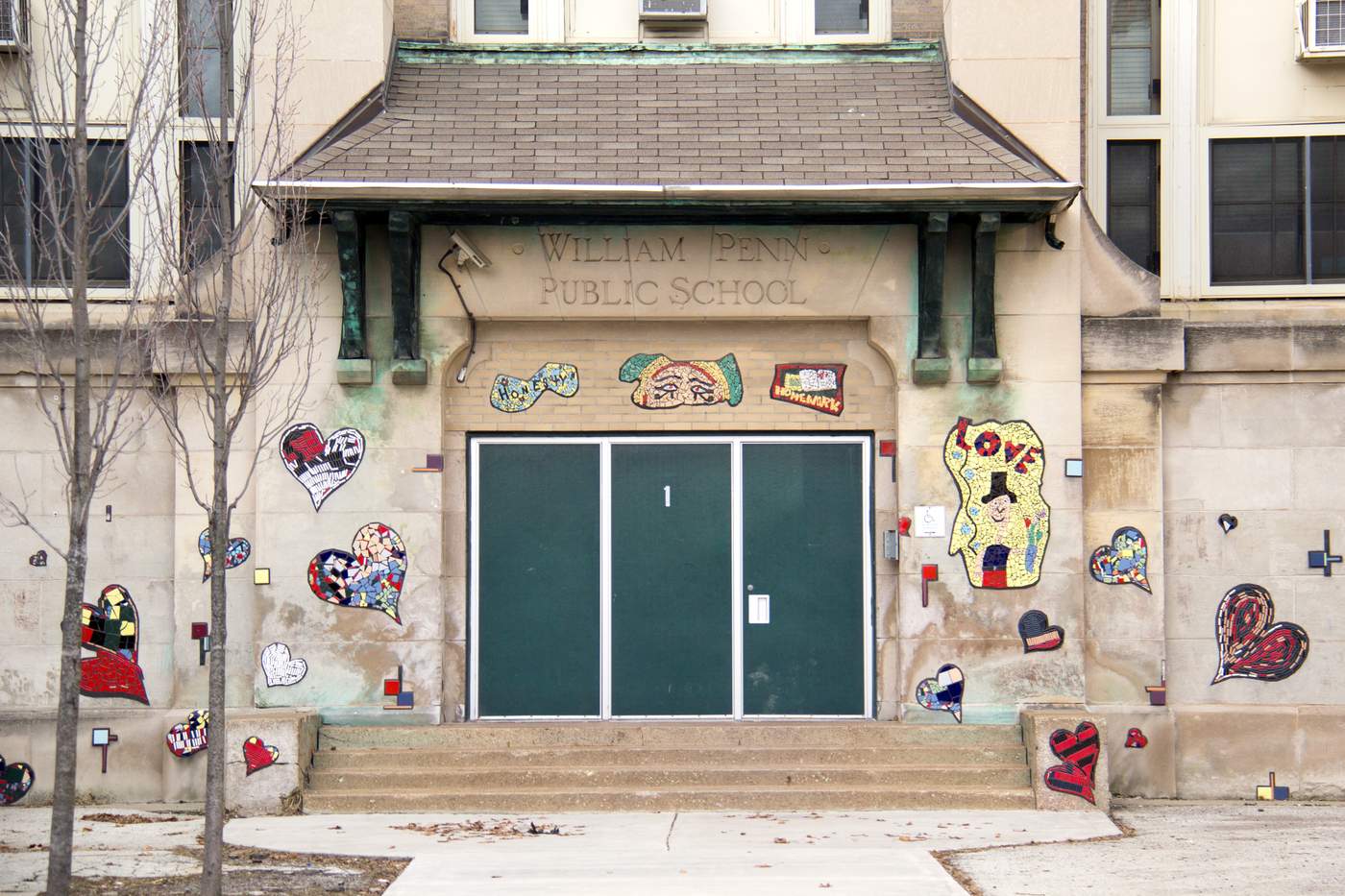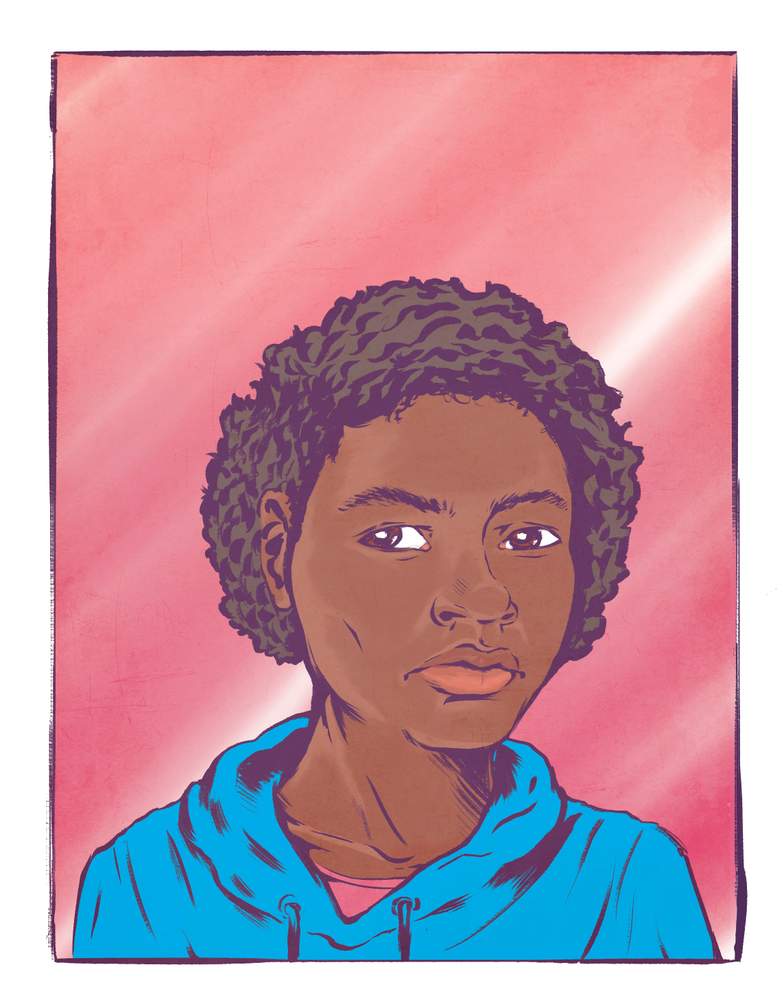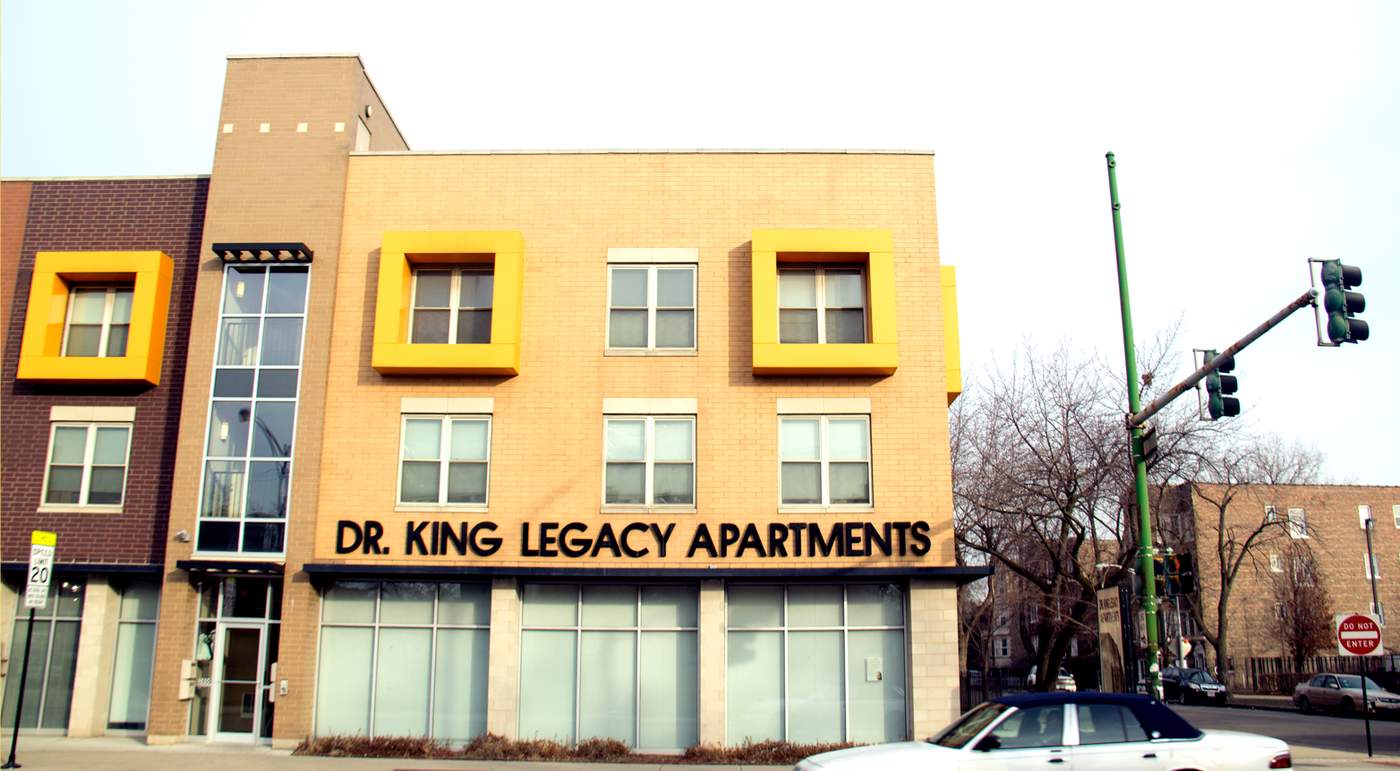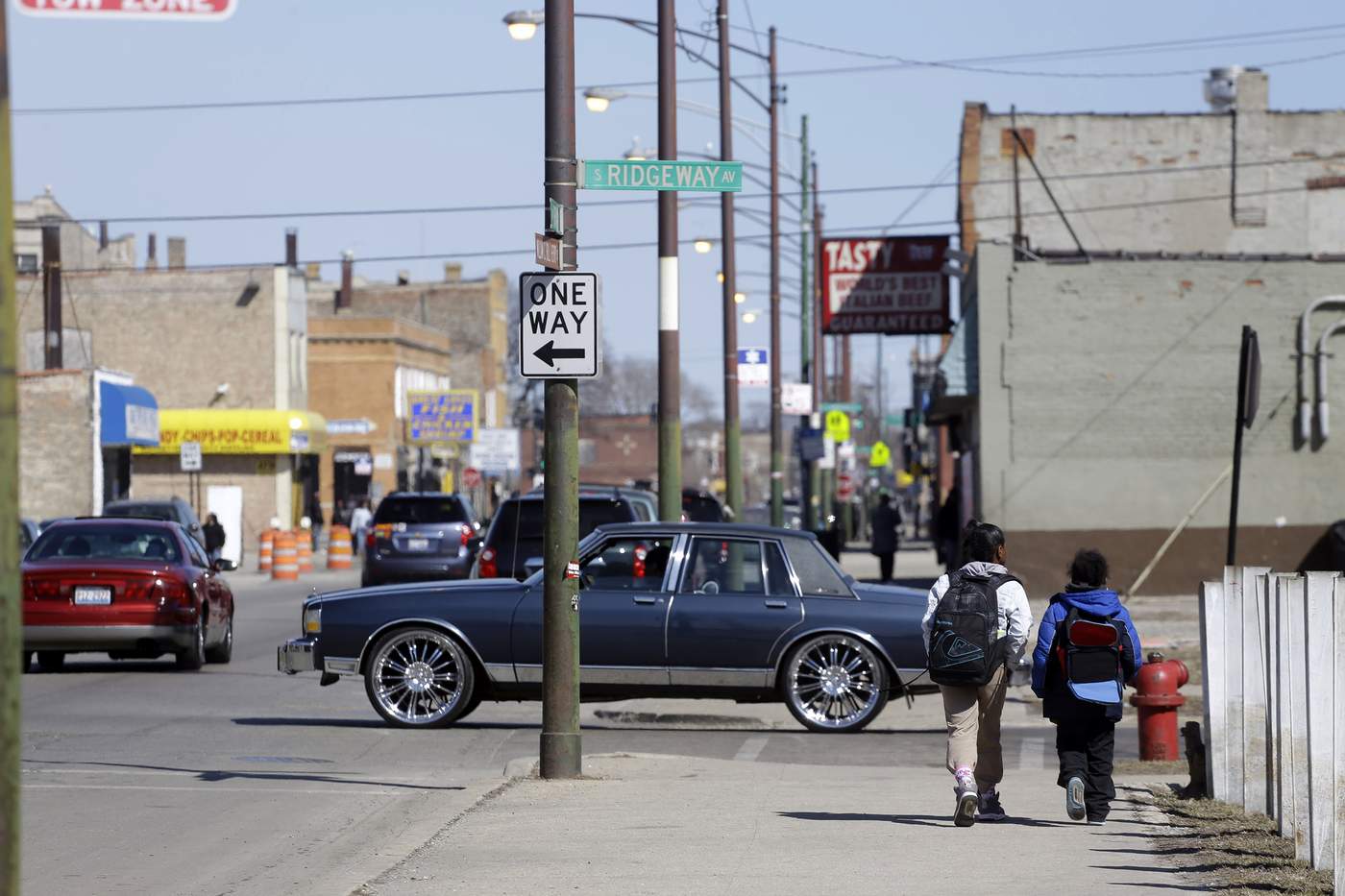This is a story about some little kids and a big idea.
The little kids are fourth graders. They go to William Penn Elementary School on Chicago’s West Side in the North Lawndale neighborhood.
It’s the first day of school, September 2014, and they’re filing into the auditorium because Mayor Rahm Emanuel is here to tout rising test scores. The head of Chicago Public Schools at the time, Barbara Byrd-Bennett, is here too.
She’s laying out the big idea that I want to wrestle with:
“No matter where you’re from, what neighborhood you call home, and no matter what your dreams are in life, it is right here at Penn that our children are going to get their start — so that they can have that dream, chase that dream, capture that dream and live it,” Byrd-Bennett tells the kids and their teachers.
The fourth graders look up at her. They’re sitting all together, pretty near the front.

They’re hearing the big idea even before they get to class: It doesn’t matter who you are or what situation you’re born into. You can make it. And school is where that happens. School is what makes the American Dream possible.
The fourth graders live in a neighborhood that really needs the American Dream. On every side of Penn are vacant lots and boarded up buildings.
“All of Chicago believes in you,” Byrd-Bennett tells the auditorium of kids. “There is no subject too hard for you to learn. There’s no dream you can’t achieve, if you stay focused and persistent.”
And with that, Byrd-Bennett makes very clear that it’s up to the fourth graders — and every kid in the room — to work hard and succeed.
It’s up to them and William Penn Elementary.
Chapter One: No Excuses
A powerful idea sits at the heart of our country’s identity: No matter who you are, no matter where you are from, every American deserves an equal chance to get ahead.
It’s why public schools were created. They’re meant to be the great equalizer.
Except, too often, they are not.
For decades, this country has come up with reform after reform to try to fix schools. We’ve adjusted what we teach, how we teach it — all in an effort to help schools put poor students on more equal footing with wealthier kids, to put them on a path out of poverty.
Recently, our country has adopted a more insistent philosophy. It’s sometimes called “No Excuses.” As in, poverty is no excuse.
"No Excuses" basically says that if schools are good enough, they should be able to overcome kids’ economic backgrounds, the poverty of their neighborhoods, and get those kids to achieve at the highest levels.
But the philosophy also says if schools can’t achieve, then something dramatic needs to change. “No Excuses” has led to a surge in charter schools, and to schools across the country being shut down.
There’s been a lot of that in North Lawndale. In fact, two-thirds of the schools in this neighborhood over the last decade have either been closed, turned into charter schools, or seen their entire staff replaced, from the principal to the lunch ladies.
Penn is hanging on.
It’s like thousands of other schools across the country that operate in this “No Excuses” moment, where everyone is on notice. It’s a typical school in a poor neighborhood.
That’s why I decided to come here.
I wanted to see up close what poverty slings at a school like that. I wanted to better understand the mystery of why so many schools in poor neighborhoods fail to do what we ask of them.
Chapter Two: Dream Big
If you haven’t been around fourth graders recently, let me remind you how great they are. They’re still curious and fun, happy to please their teachers. They get excited about simple things, like chocolate pudding for lunch.
If anybody’s going to take the mayor and head of Chicago’s school system at their word — that they ought to dream big and be persistent — it’s the fourth graders in Room 205.
At the helm is Carolyn Hathorne. If you saw her in the supermarket, you might guess she’s a teacher. She wears turtlenecks and teacher sweaters, sturdy shoes. She’s been teaching for four decades, and this day, she gets things started by asking what her new charges know about fourth grade.
“I know that fourth grade is not going to be easy,” one student offers. “I know that we are going to have to take a test. I know that I might not pass.”
Ms. Hathorne explains that the state dropped the standardized test they took last year.
“Lord, thank you!” one of the fourth graders exclaims, as if God himself struck down the test.
“Well,” Ms. Hathorne says, “if that one went away, there’s a new test…PARCC.” But the fourth graders already know about PARCC, and the other standardized test they’ll take three times this year.
The kids in Room 205 are only about an hour into fourth grade. Instead of imagining science experiments, art projects, field trips, they’re talking about standardized exams.
That’s not unusual at high-poverty schools like Penn. The tests are how we measure a school’s success. It’s how we decide if all the reforms are working.
In middle-class schools, where kids score well, the tests feel more like an afterthought. But in high-poverty schools like Penn, the tests are center stage.
Ms. Hathorne oo’s and ah’s the good answers she gets from her new students.
“I’m delighted. I think I’m gonna like this year!” she tells them.
But privately, as she looks out, she also sees the challenges before her.
There are 30 kids in the class. And — try to imagine this — 23 are boys. One is the son of a former gang leader. One is depressed and on medication, at age nine. Several children have parents in jail, or recently released.
Chapter Four: What Poverty Slings
Ms. Hathorne’s class is learning prefixes.
Kelsey is working with a partner. And he’s doing a little dance right by his desk — which he does unconsciously almost all the time.
Many of the words they’re supposed to modify with their new prefixes are words they don’t know. Words that neither school nor life along 16th Street has taught them. Like the word ripe.
I can’t name a store along 16th Street that sells fruit.
“Ripe bananas are yellow,” Ms. Hathorne says. “The bananas that are green…”
“Are ripe,” Kelsey guesses. “Are rotten,” his partner guesses.
Ms. Hathorne tries again. This is her second group of students struggling with the word.
“What would you say about them, if they’re not yellow?”
“I would say they’re not all the way grown,” Kelsey says.
He and a friend lean over a dictionary, eventually finding the answer.
Unripe: not fully grown.
I want to paint a picture of the neighborhood just outside Room 205, where these 30 fourth graders live. Imagine TV footage you’ve seen of Detroit or Baltimore, or the worst parts of New Orleans a few years after Hurricane Katrina.
North Lawndale's Katrina has been a decades-long storm of disinvestment, slow and thorough.
One day I ran into Kelsey outside, right by Penn.
He was with his brother, and we were talking for a while before I realized the conversation kept coming back to the same place.
Did I have any candy? Gum?
“I had a lot of chips today,” Kelsey says. “I don’t want no more chips.”
Since there was no school this day, there was also no school breakfast or lunch.
A guy from a social service agency happened to pass by. He tossed each of the boys a little bag of chips. Kelsey’s brother Kelton finished his own, then started eyeing Kelsey’s.
I asked the boys if they were hungry. Yes.
I asked what they’d eaten that day. “We ate chips, and that’s all,” Kelsey says.
It was almost 5 p.m.
Sometimes it feels like there just isn’t enough food in Lawndale. There’s been an increase in people living on $2 a day or less in this country — and Lawndale is one of the places they live.
Homes that stay dark after the sun goes down? Not enough for the light bill.
One of the fourth graders’ relatives was arrested for drugs at one point. In 24 hours, among everyone they knew, the family couldn’t put together $100 for bail. They got to $40.
One of the fourth graders’ moms sometimes sells her body.
I ask if Caprice was the first person Chelsee knew who was shot. She looks at me, puzzled almost.
“I remember everything. My Uncle Ken got shot when I was five,” Chelsee says. “I had another cousin named Will, I grew up with him. He helped my Mama take care of me when my Daddy was in jail. He had got shot in the head three times and Caprice got shot two times.”
While I was with the fourth graders in Lawndale, Arne Duncan was the U.S. Secretary of Education. He was in Chicago at one point for a conference.

Arne Duncan was U.S. Secretary of Education from 2009 until 2015.
(Charlie Neibergall/AP Photo)
I told Duncan about the fourth graders in Room 205 and we talked about all their potential. But we also talked about them being hungry, the violence, families falling apart. He knows this stuff, especially in Chicago, where he led the school system.
I asked if he had a message for Penn’s fourth graders.
Have faith, he said. Work hard.
“And, you know, as tough as it is, as much as the odds may seem stacked, kids very similar to them have beaten those odds and done extraordinarily well, so there’s nothing that says that they can’t make it,” Duncan added. “Is it a more difficult road or a more difficult climb? Unquestionably, yes. But use that as fuel to try to go to the next level.”
Maybe I wasn’t fair to Arne Duncan.
Honestly, I wouldn't tell the kids any different.
I’d tell them to work hard. Do your homework. I’d tell them: “You can do it!”
But you can hear how that message sounds in the face of everything they’re up against.
And I struggle more and more with that message the longer I stay in Lawndale.
The problem isn’t that we tell poor kids they can make it.
The problem is we haven’t made a world for them where that’s true.
Chapter Eight: The Big Picture
The big picture is not easy to look at. It doesn’t fill us with hope.
It looks like this: The more poor kids in a school, the lower the scores.
Nothing better predicts how kids will do on standardized tests than where they sit along the spectrum of poverty and privilege.
Of all the high-poverty school districts in the entire country, not one scores even at the national average.
And the gap between how rich kids and poor kids do in school is actually growing.
Decades of fixing schools has not shaken poverty’s hold.
This is what we have to wrestle with if we want to make the American Dream real for poor kids.
Chapter Nine: The Man Who Lived Across The Street
I am not the first person to look at poverty from this very spot.
In 1966, Martin Luther King, Jr. moved into a dilapidated apartment right across the street from William Penn Elementary. If the building were still standing, the fourth graders could see it from the playground.
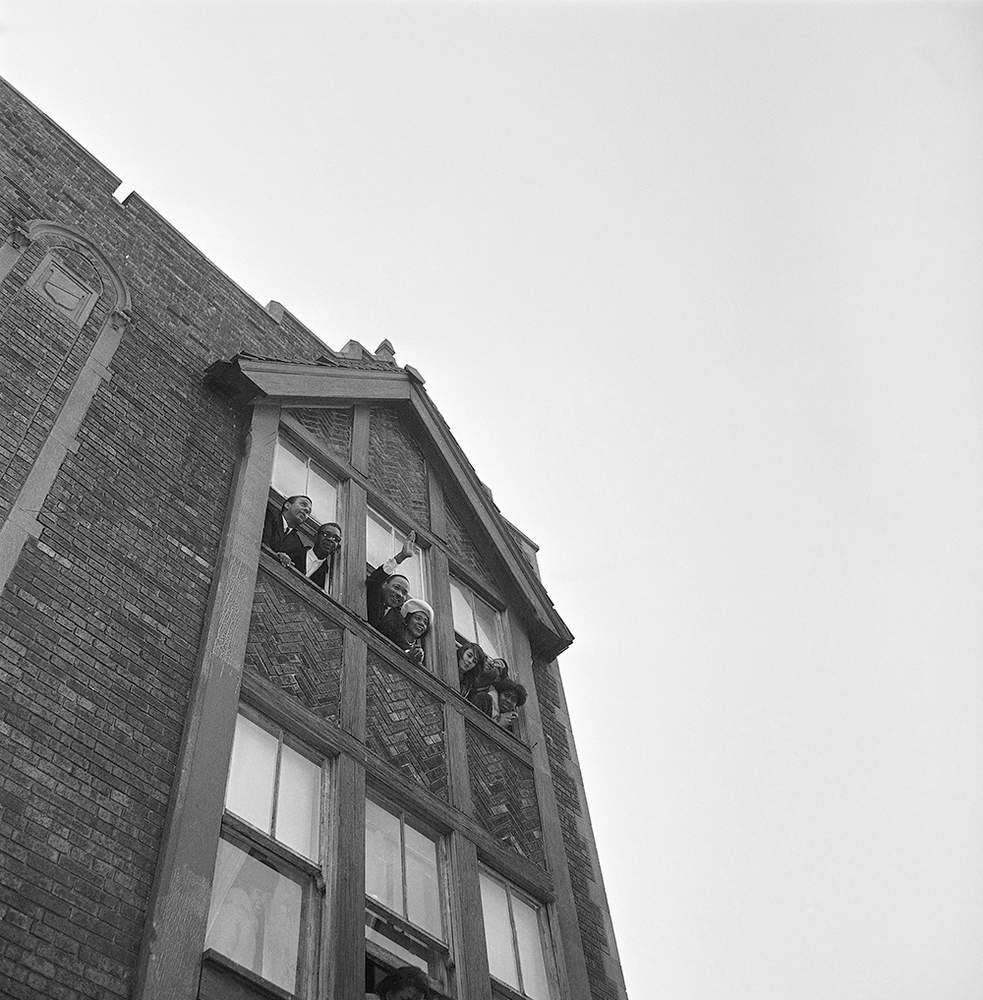
Dr. Martin Luther King, Jr. moved into a dilapidated North Lawndale apartment in 1966 to call attention to poverty. (AP Photo/Edward Kitch)
In North Lawndale, King’s stairwell smelled like urine, the door to the street wouldn’t lock. This was after he’d won the Nobel Peace Prize, after Birmingham and Selma. Now his target was poverty.
He wanted an end to what he called slum jobs, slum wages, slum schools. And his message sounded really different from what you might have heard before.
“When a man does not have a good job and good wages, he’s a slave,” King said in Chicago in 1965. “When a man cannot live in good substantial housing conditions he’s a slave.”
King wanted the government to battle poverty head-on. He called for a huge increase in the minimum wage and massive investment in neighborhoods like this one. He wanted everyone to be guaranteed a basic income.
King said this would be the hardest part of the Civil Rights Movement, because it was going to cost society something: “It’s much easier to integrate a bus than it is to get a program that will force the government to put billions of dollars into ending slums,” King said.
Almost nothing of what King called for has been implemented in Chicago, even partially.
That feels really obvious if you visit Lawndale.
About a block from Penn Elementary, the Del-Kar Pharmacy is one of the only businesses that has hung on these 50 years. Neighborhood legend has it that King bought his newspaper here.
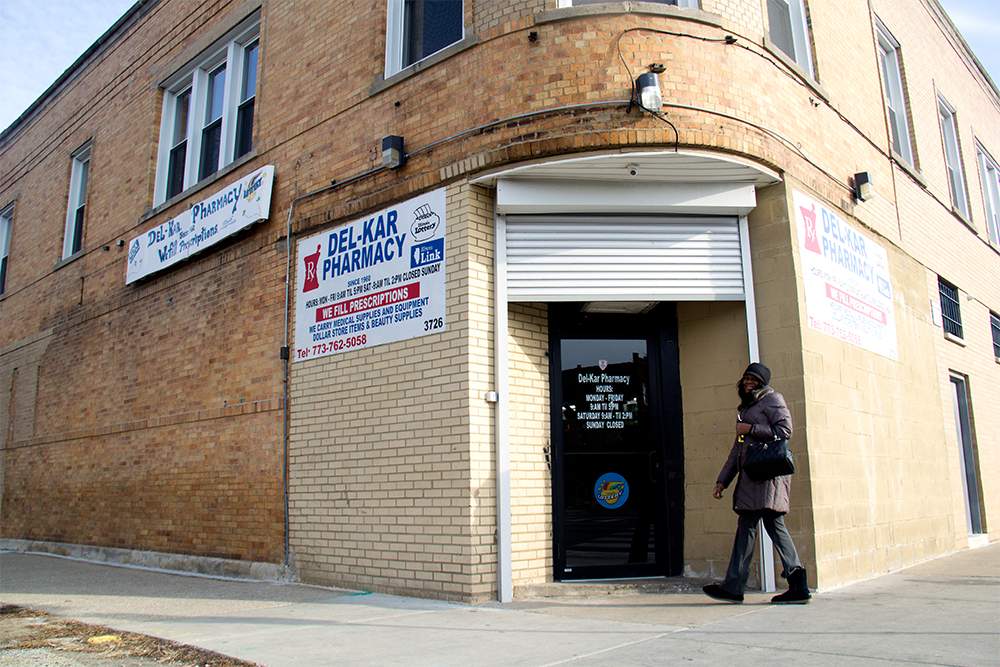
Andrew Gill/WBEZ
A bunch of old photographs in the pharmacy show a bustling 16th Street — grocery stores, department stores, dentists, nightclubs.
The astounding thing about those pictures is how good things look. I have to keep telling myself this was the slum King was trying to end. It looked so much better than 16th Street today.
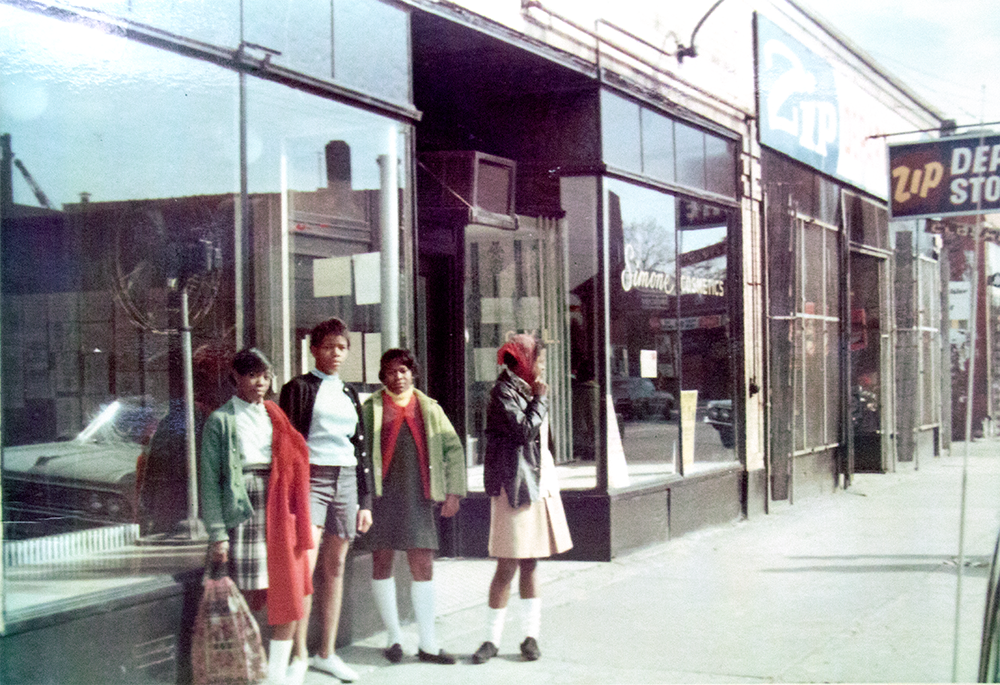
Courtesy of Edwin Muldrow
Today, the poverty rate is higher in this neighborhood than it was in 1966; 76 ercent of Lawndale residents older than 16 don’t have a job.
Chapter Ten: Cutting Corners
If anyone can help North Lawndale kids out of poverty, it should be Sherryl Moore-Ollie. She’s Penn’s principal. She grew up in North Lawndale.
“Those kids are me,” Dr. Ollie says. “I was them.”
She knows what it’s like to have to double up with relatives who are barely better off than you are. She still remembers the day an abusive boyfriend stabbed her mom on the street, little Sherryl by her side when it happened. Gangs lured her brother.
Despite all that, Sherryl Moore made it. She was her high school valedictorian and graduated from Illinois’ best public university. Today, she has her doctorate.
“So I know that success happens in communities like this,” she says. “I don’t care if your shoes are flipping at the bottom because that’s the only pair you have. You can do this, no matter what.”
We want Dr. Ollie’s story to be everybody’s story.
But when you hang out at Penn long enough, you see the complicated dance Dr. Ollie and the teachers do to try to make Penn live up to its promise.
She hired an extra third grade teacher to keep class sizes down. But that means art is taught by two parents. And music is taught by a contractor.
Their instrument? The orange Home Depot five-gallon bucket.
It’s a chaotic class. “It always hurts my ears,” Jamariya said one day.
Dr. Ollie resents having to cut corners. And her students need so much more. There are 367 kids at Penn. It’s one of the neediest schools in the city. But just 18 get time with a social worker. Not a single fourth grader in Room 205 qualifies.
But even if Penn had all the resources of a wealthy school, the world outside would be just as mean.
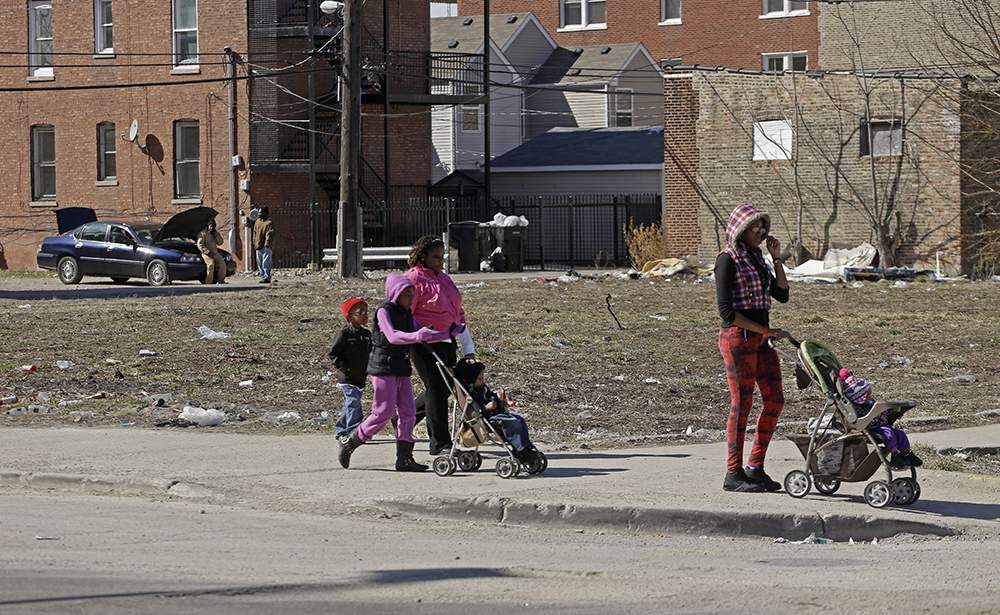
(AP Photo/M. Spencer Green)
There would still be no fruit on 16th Street and no jobs. There would still be no parent to call about Kareem, the boy who’s mostly raising himself.
Little bits of Kareem’s history have appeared in the newspaper. Like a story about Kareem’s mom allegedly killing her boyfriend with a steak knife, all six kids at home. The youngest was Kareem.
Every time I come by Room 205, Kareem is getting in trouble. Today Ms. Hathorne tries to take him out of class and walk him down the hall.
Kareem says he’s not coming and slowly starts to cry. He’s standing against the wall in the hallway, under his hood. Ms. Hathorne calls the security guard to get him to class.
Kareem is really sobbing now. To me, it seems so obvious that something else is going on. I think Ms. Hathorne probably sees that too. But she has a broader mission: 30 kids.
By now I know lot of things that could be making Kareem cry.
Maybe it’s the unanswered Christmas letter Kareem sent to his dad in prison. Ms. Hathorne helped him write that. Maybe it’s his mom’s addiction to Leaf, a drug that’s all over Lawndale. On the day she’s supposed to check into rehab, she can’t make it.
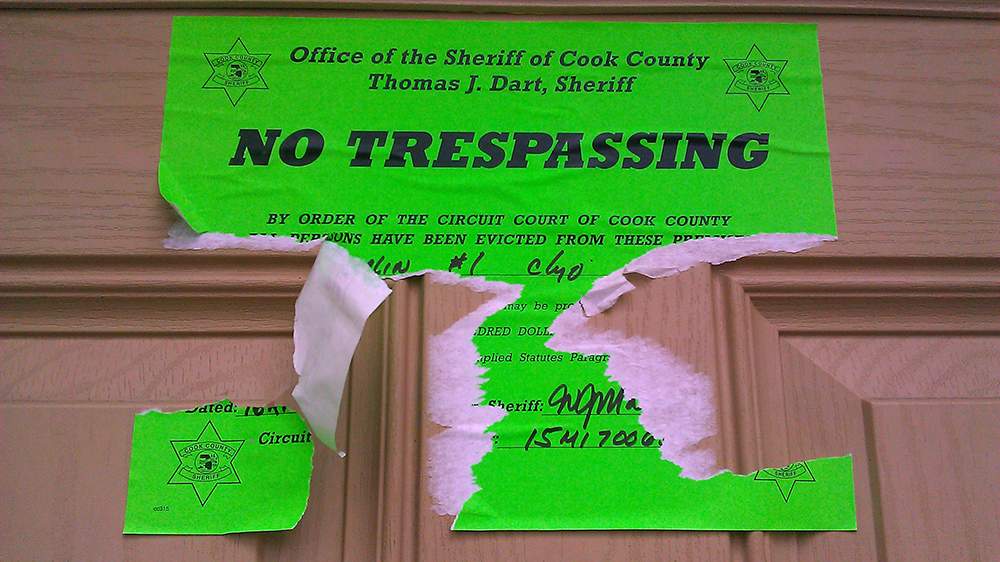
In the spring, an eviction notice was posted on Kareem's family's door. (Linda Lutton/WBEZ)
We have this idea that schools can be radically different from the communities they’re sitting in. We want schools to be havens. And Penn really is a haven in many respects. But schools are not impervious.
Penn called the police 22 times in the school year I was there. That’s about once every other week.
One day a foster care worker arrived at Penn. She came for Kareem. She was with three police officers in case Kareem or his brother or sister tried to run.
Penn’s assistant principal called the kids out of class and Kareem cried: “We’re not gonna be together!”
Dr. Ollie couldn’t watch. She stayed in her office.
The three kids were taken to an emergency shelter on the South Side, pretty far away. Dr. Ollie convinced their new foster mom to bring them back to Penn for school.
Chapter Eleven: Make It Happen
In the spring, when Principal Ollie goes to a performance management session with district officials, they pick apart every thing that can possibly be measured at Penn — test scores, attendance rates — all down to the tenth of a percentage point.
When she gets back, she shares a torrent of frustration with her assistant principal.
“They don’t understand what we deal with,” Dr. Ollie says. “I mean, 100 percent attendance would be perfect — if we had perfect families. You know? But we don’t.
“Nobody cares about circumstances but us. They just want us, you know, ‘You gotta get this. Make it happen.’ So we just keep spinning our wheels trying to figure out how to make it happen. How do we do it?”
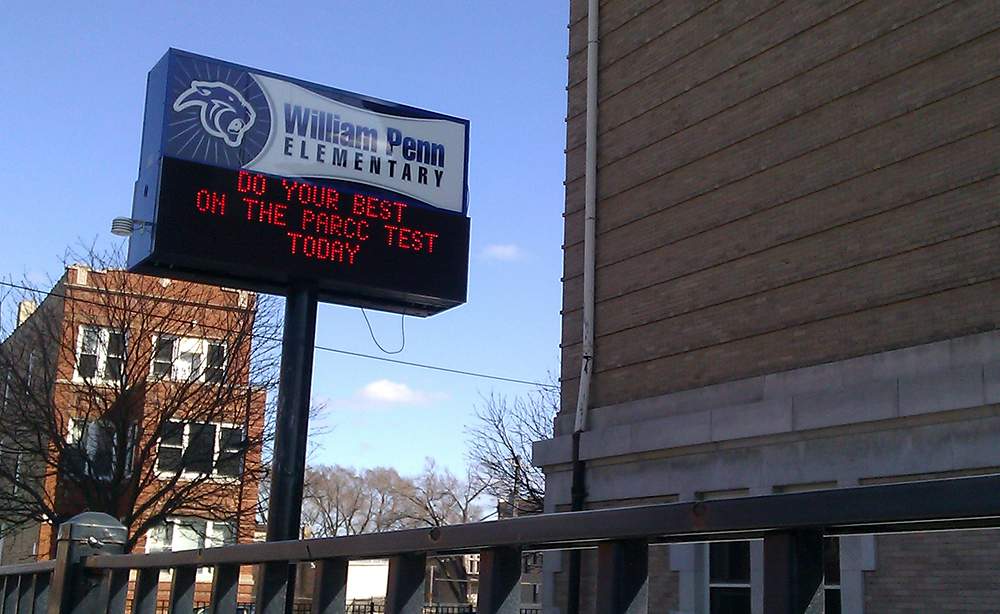
(Linda Lutton/WBEZ)
The week before the big PARCC test I stopped at a staff meeting in the principal’s office.
The third, fourth and fifth grade teachers were gathered, including Ms. Hathorne. The topic was the upcoming PARCC test.
Each teacher was looking at a test booklet or a photocopied test booklet.
The PARCC tests arrive in the mail. School officials are told to keep the box under lock and key until they give the exam. That’s how serious security is around these tests.
But now here were the teachers looking at the actual test. They were poring over reading passages and questions.
“We already read this — oh good!,” one teacher says.
I acted like it was normal to see teachers paging through the state standardized exam.
But all I could think of was: Why are they doing this? I did not want to be seeing this.
The principal confirmed they were reviewing the actual test, the one students would take the following week. I ask if that is allowed.
“We can give them the test before the test happens,” she says. “I want to familiarize them with the format of the test, but it doesn’t say that they can’t have the test before the assessment. So, hopefully they can!”
Actually, no, they can’t. That’s really clear in all the rules schools are given about this test.
I didn’t come here to report on standardized tests or to do an exposé.
My thing was to see up close what poverty throws at 9- and 10-year-olds and how their schools respond.
It wasn’t until later that I realized that what I saw at that staff meeting was part of my story. It’s part of what we get by telling schools that there is no excuse for low scores.
I’m not saying we get cheating every time. I’m not even sure if I should call what happened at Penn cheating.
Sometimes I would leave Penn, turn on the news in my car and hear about big, blatant cheating: Like Atlanta, where teachers were told to get scores up “by any means necessary.” They changed kids’ answer sheets.
That’s not what I saw at Penn. But the pressure feels the same.
With just three weeks left of school, everybody in Room 205 lines up.
They march downstairs to a basement computer lab to take the highest stakes test of the year, in a pale yellow, cinderblock room. The kids’ scores will help determine Ms. Hathorne’s rating as a teacher and Penn’s rating as a school.
Nearly all the kids are carrying their class planners, which have a whole reference section inside, with multiplication tables, shapes, money and decimals. Ms. Hathorne had instructed the kids to bring them, which is weird, since no reference materials are allowed during testing.
When I wandered back, testing was wrapping up and Ms. Hathorne asks me to wait.
As they were lining up to go, planners in hand, little Kelsey came up to me quietly and whispered right into my microphone: “They don’t like you.”
These things I saw — teachers looking at the test ahead of time, kids using reference materials during a test — they’re wrong. Of course they’re wrong.
They’re also the only things I’ve said in this story that would ever make a news headline.
You can probably imagine that news story, too. The principal on the hot seat. The teacher. All the fingers pointed.
But now, imagine all the things I’ve told you about that would never get a headline.
That would never get attention. All you wouldn’t know about Penn.
You wouldn’t know that the fourth graders learned the word ripe from a dictionary. You wouldn’t know about the killing of Chelsee’s cousin or about Kelsey missing breakfast and lunch. That’s not news. You wouldn’t learn that no one in Room 205 gets time with a social worker.
A week after Room 205’s big test I ran into Ms. Hathorne in the hallway. She brought up what I had seen with the class planners, saying she had struggled over what was right.
“I’m sorry I did [it]. It didn’t help the scores,” she says. “My kids have always achieved. This is the first time that I’ve ever put myself in a situation like this, so that makes people wonder, ‘Has she been credible for the last 20 years?’
“I know Penn is so close to being closed,” she continues. “And I think I let my emotions get in my way... So much is dependent on achievement, in terms of whether your school doors stay open, whether people maintain jobs...There’s so many things in a school like this that should be in place, in terms of helping children to be successful.”
I tell Ms. Hathorne that is the whole point of me being here — to see what Penn is up against.
“Don’t nobody care,” she says. "That's the bottom line, Ms. Linda. Nobody cares."
Maybe you’re thinking that the whole problem here is not poverty. It’s Penn. Maybe you’re thinking that a good school could overcome all this.
Just down 16th Street is a charter high school. Many Penn students come here after eighth grade.
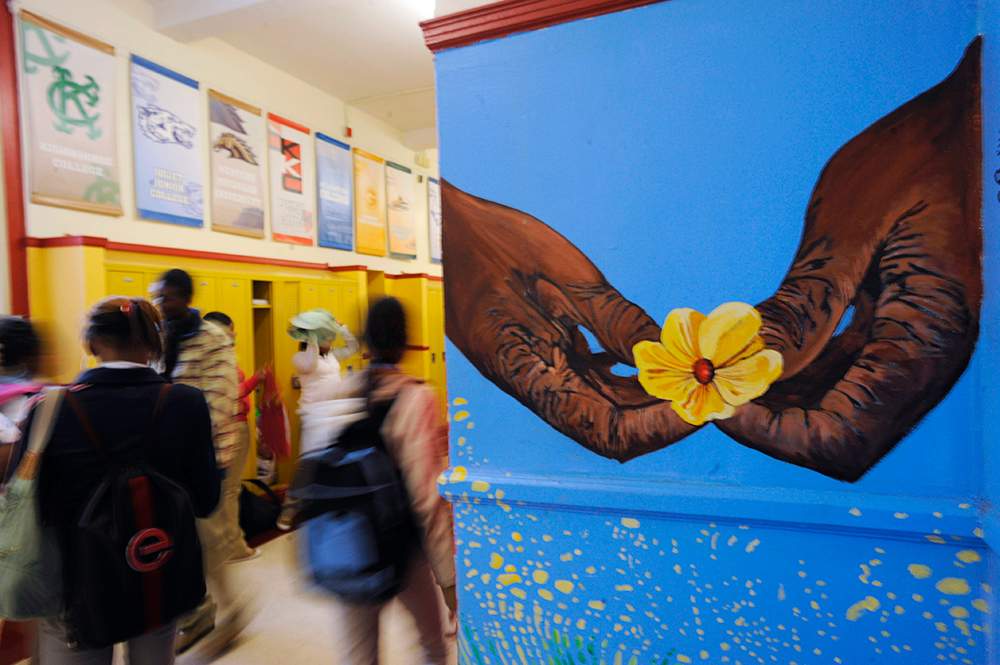
The halls of North Lawndale College Prep
(AP Photo/Paul Beaty)
It was started 20 years ago by a former Catholic priest, John Horan. His goal was to get Lawndale kids into college. That’s pretty much the only path out of poverty these days.
“I didn’t know back then how much it would take and how many obstacles that kids and families had to fight through,” Horan says. “I thought we’d be able to do this, that it would be a snap, but it’s not a snap!”
So the school added social workers, trips to colleges, a fund for student emergencies. He’s gotten donors to pay for it all. Many more kids are going to college thanks to his school, but it’s far, far from half.
So now the school is getting even more aggressive. Horan is planning housing for the most vulnerable students, like a dorm. They won’t have to worry about eviction or food or heat in the winter.
Is this what schools must do to become the great equalizers we want them to be?
Chapter Twelve: What If?
I want to tell you about the end of the school year at Penn.
All the fourth graders in Room 205 passed to the fifth grade.
They also celebrated Kareem’s birthday with cupcakes.
Penn did not meet its testing goals the year I was there — despite all efforts, legitimate and not so legitimate.
More recently, scores are back up. Penn students scored the same on the PARCC test as the charter school upstairs. They scored higherthan the re-staffed schools in Lawndale. Of course, all those schools are still miles below where middle-class kids score.
We believe schools can overcome poverty. But what if we're wrong?
What if we’re putting way too much faith in schools to overcome all the obstacles poverty presents? I’m not suggesting that would be true because poor kids are any less bright or talented or because they don’t work as hard.
But because money — the kind of money that middle-class or affluent people have — buys experiences that help kids understand the world, understand the word ripe.
It buys music lessons and sports practice, connections to people with jobs and opportunities.
Money buys dinner every night, a neighborhood where kids are not shot, a school with more resources. Money buys freedom from the stress poverty brings.
I want to be really clear: I think we should work as hard as possible to make schools as good as we can make them. It’s where our kids learn to be thinkers and citizens.
But what if we’re just plain wrong about schools being able to overcome poverty?
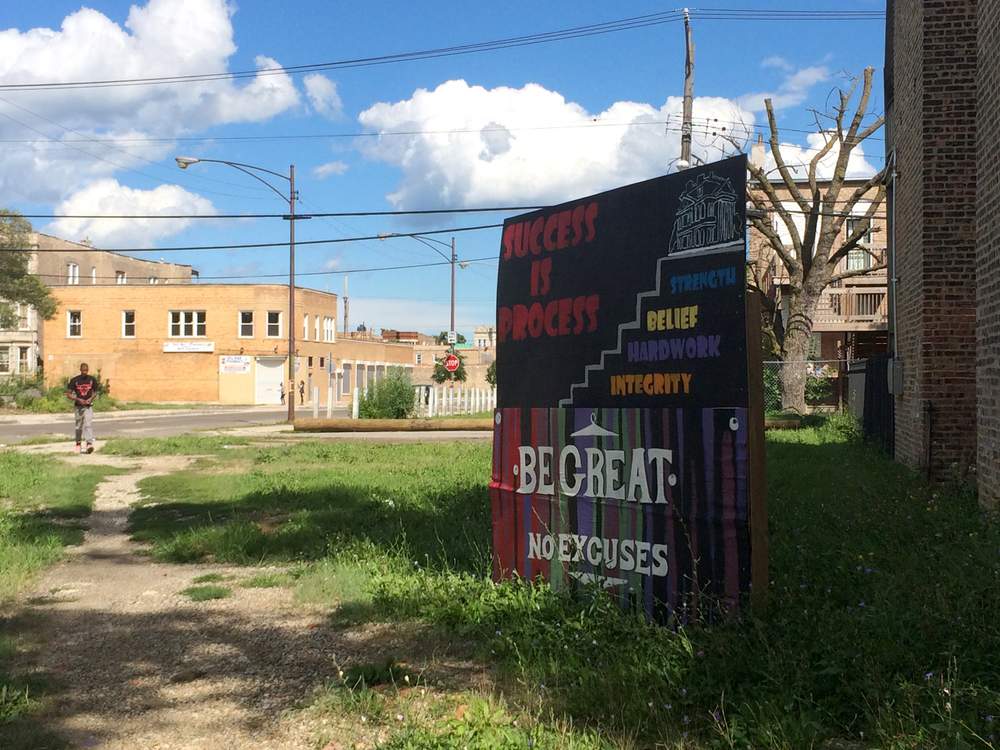
(Linda Lutton/WBEZ)
That would mean that all our school reforms, decades of them, might be making schools better, but they’re not making the American Dream come true — not for kids in neighborhoods like Lawndale.
After his time in Lawndale, Martin Luther King Jr. became even more convinced that poverty should be attacked head-on.
He said trying to fix education or housing is just too indirect: “Each seeks to solve poverty by first solving something else,” he wrote.
The most ardent supporters of the idea that schools can overcome poverty often call education the “civil rights issue of our time.”
They challenge the quality of schools, and they’re right to do that. But they don’t go after what King was challenging: The conditions kids live in, the conditions in which school takes place.
The View from Room 205 was produced by WBEZ Chicago. It was edited by Marianne McCune, with Cate Cahan. Production by Joe DeCeault. The executive producer is Ben Calhoun. Reporting during the 2014-15 school year at Penn was supported by a Spencer Fellowship in Education Reporting at Columbia University’s Graduate School of Journalism.
Much of the music used in this documentary was created and copyrighted by Blue Dot Music, and used here under a Creative Commons license for noncommercial use. Music used comes from the albums Marble Run, Crab Shack and Nursery.
Linda Lutton, a reporter at WBEZ, has been covering education and youth issues in Chicago for more than a decade. Her work has been broadcast on This American Life, Re:sound, Marketplace, The World, and NPR’s Morning Edition, All Things Considered, and Weekend Edition. She’s received many honors, including a 2014 Peabody Award. She extends her gratitude to all involved in the production of "The View From Room 205". You can follow Linda at @WBEZeducation or email llutton@wbez.org


